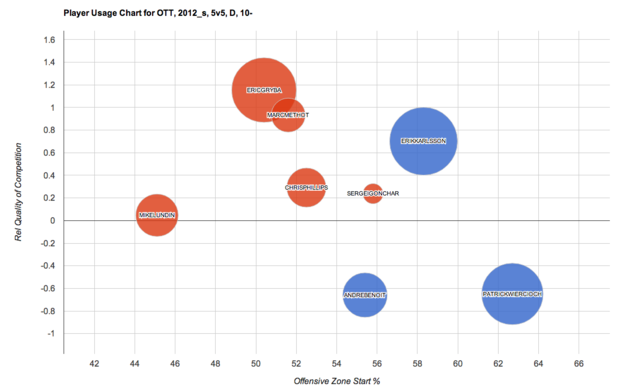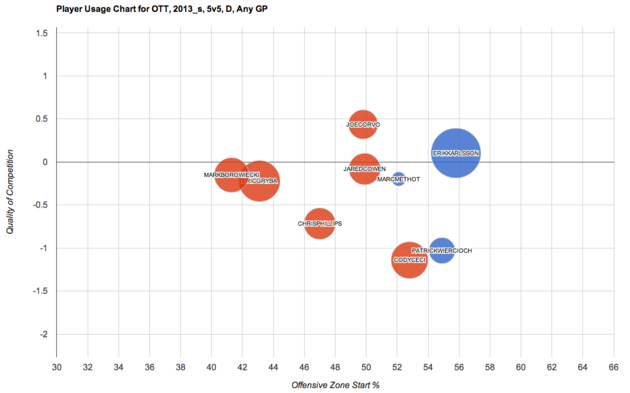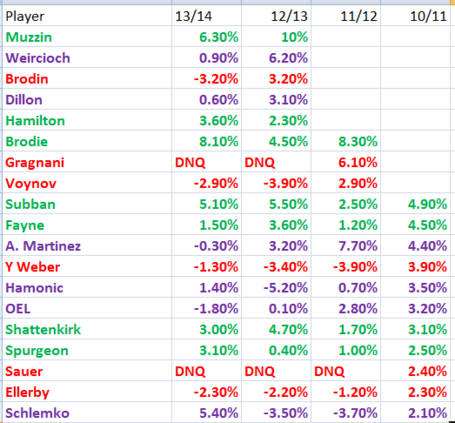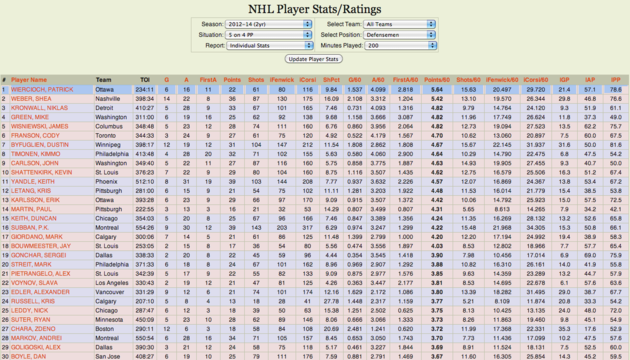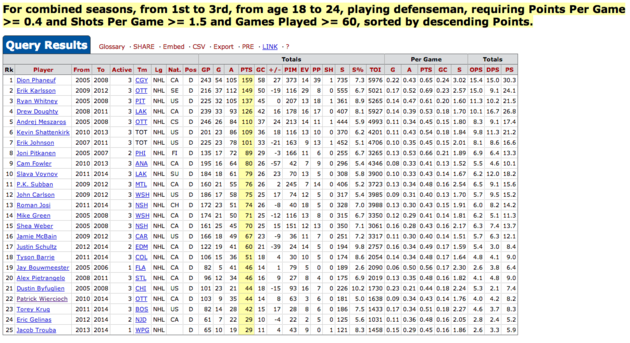Top 25 Under 25, no. 6: Patrick Wiercioch
Patrick Wiercioch is a combination of two things everyone loves: size, and puck-moving ability. Listed on the Senators website as 6'5, 203 lbs, the 23-year old Wiercioch found himself in the press box for much of the year despite high expectations after his solid lockout shortened season. This article will give some background information on Wiercioch as a prospect before moving into his performance thus far, in order to assess why he's Silver Seven's 6th ranked prospect.
Background
Wiercioch is not new to adversity. The sole piece remaining from the Martin Havlat trade, Wiercioch spent two years at the University of Denver before taking an unorthodox route and turning pro instead of staying to finish out his NCAA eligibility. Why? He probably saw opportunity after looking at the pile of hot garbage that was the 2010-11 Senators blueline: Benoit, Campoli, Carkner, Gonchar, Hale, Karlsson, Kuba, Lee, Phillips, and Derek Smith. To put this in perspective, only Erik Karlsson plays top-four minutes three years later, and six of the players don't have regular NHL contracts. However, much to Wiercioch's chagrin, he was still growing into his frame and was not strong enough to play at the NHL level, and thus, ended up in Binghamton for the next two seasons to work on his game. In 2011-12, right when Wiercioch was about to catch a break, he suffered a life-threatening injury after being hit in the throat by an errant puck, and was sidelined for a couple months. He recovered and came back with a vengeance in 2012-13, putting up his best point/game rate in the AHL (19 in 32) before equalling that in 42 games at the NHL level - the second best point total among rookie defensemen after Jake Muzzin of the LA Kings.
Just before this season, James Gordon of the Ottawa Citizen, using some numbers from our friends over at the 6th Sens, had this to say about Wiercioch's lockout year:
There was more to his campaign below the surface. Fan blog The 6th Sens crunched some more numbers, noting 71 per cent of those assists were primary ones. Wiercioch also averaged almost two shots per game and had the third-best even strength scoring chance differential on the team (plus-32) behind former captain Daniel Alfredsson and Karlsson. He was also second in relative Corsi – a statistical measure that tracks puck possession — though he did benefit from playing lower on the depth chart against weaker opponents.
The bolded part is added by me, and is a common concern of Wiercioch detractors - he plays against weaker competition. We're now going to explore his quality of competition by first examining the defense over the past two years via player usage charts, before going into the importance of his performance in those minutes relative to the rest of the Senators defensemen.
Player Usage
Here's a player usage chart for Sens defensemen (min. 10GP) for the 2012-13 and 2013-14 seasons. You can create these from a variety of sources, including Hockey Abstract and formerly Extra Skater, but this one is created using Greg Sinclair's tool here.
The X-axis reflects the player's offensive zone starts, with a number greater than 50% (far right) reflecting a player starting more in the offensive zone, and a number less than 50% (far left) reflecting a player starting more in the defensive zone. This is controlled by coaches and the logic is usually: the better offensive players start in the offensive zone, and the more defensive oriented players start in the defensive zone. Poorer offensive zone starts (<50%) are commonly linked to that player playing "tougher" competition, because you're generally going to get outshot by the opposition in the defensive zone and this will reflect poorly on your possession numbers compared to players who get a prime opportunity for shot attempts in the offensive zone (>50%).
The Y-axis reflects the player's relative Quality of Competition based on shot attempt metrics (Corsi). The higher the number, the tougher the minutes played by the player. Lastly, the colour of the bubble represents whether that player had positive possession numbers (blue = greater than 50% Corsi) or negative possession numbers (red = less than 50% Corsi). You want the colour to be blue, because that means your team is out shot-attempting the other team when you're on the ice, which is a good indicator that you're going to get more scoring chances, and eventually, goals for. Bigger blue bubbles mean that when the player is on the ice, the team is outshooting the other team by a good margin (smaller blue bubbles less so), and bigger red bubbles mean the opposite - you aren't faring well in the possession battle.
This can help us infer the difficulty of the minutes faced by the player, and the usage of said player by the coach. Everyone would love to have Patrice Bergeron's and Anze Kopitar's - players who face high competition, have poor offensive zone starts, but still dominate the shot-attempt battle (blue bubbles), but those types of players are rare.
In 2012-13, we can see that the team outshot their opponents heavily with Wiercioch on the ice, almost to a similar extent as Erik Karlsson, but that Wiercioch played the easiest minutes on the team, starting in the offensive zone ~62% of the time, and facing 'easier' competition relative to his teammates. After Karlsson went down, the pairings were generally Methot - Gryba, Phillips - Benoit, and Wiercioch - Gonchar, with MacLean choosing to send Methot - Gryba to face really tough competition in order to give the other two pairings a chance to succeed.
This performance gave us the indication that Wiercioch was ready for an expanded role in 2013-14, but as we can see, things didn't go as planned. Wiercioch faced similar quality of competition, but the blue bubble (representing possession) is a little smaller. Garik16, an author at Hockey Graphs, took a look at the performance of rookie defensemen who posted positive possession numbers in their first year. There have only been 19 rookie defensemen who have played 40+ games and had a 2+ relative Corsi number, a metric that looks at how a player does possession-wise relative to his team. A higher relative Corsi number means that the player was a possession-driver on his respective team, and helps tease out team effects due to the average Corsi number being the team average, rather than the standard CF% of 50%.
The names in Green followed up their strong rookie seasons with very good possession numbers, whereas the players in red had poor possession numbers. The players in purple, including Wiercioch, had mixed results from season-to-season, and Garik16 speculates that a lot of this has to do with context: rookie defensemen usually play easier minutes and have softer zone starts, and thus struggle the next year when asked to step up. When comparing to his peer group, we can see that Wiercioch's performance is not an outlier (6/19 d-men had mixed results), and still features some big names who also struggled like Oliver Ekman-Larsson and Travis Hamonic.
As we just saw earlier, Wiercioch played around similar minutes in terms of zone starts and quality of competition, so why did he struggle? His performance can partly be attributed to the fact that Wiercioch, normally a left defenseman, was asked to play the right side, and although he excelled in training camp, his pairing featuring Jared Cowen struggled early, which led to Wiercioch being scratched for a majority of the season. I'd argue that this punishment was unfair to Wiercioch, especially when it was reportedly due to "intensity" concerns in practice, seeing as the team still outshot their opponents with Wiercioch on the ice, which didn't happen often otherwise. This season hindered his development as we were unable to see whether Wiercioch could play against tougher competition, seeing as he wasn't consistently in the line-up, but it's something that we should keep an eye on for this year, and I strongly believe that Wiercioch deserves the opportunity to prove himself given his peer group's performance over the past four years.
Performance
While we're on the topic of unfair reasons for Wiercioch to be scratched, I thought we'd take a look at some data by Corey Sznajder, who's currently tracking a number of things, including zone exit data, for every single NHL game this season. There were a number of times this season where Ottawa struggled because the team could not exit the zone, and tracking micro-events such as these can help determine who on the team is specifically struggling in this area. Here's a quote from Phoenix Coyotes coach Dave Tippett on the effectiveness of different types of defensemen:
"I'll give you an example. We had a player that was supposed to be a great, shutdown defenseman. He was supposedly the be-all, end-all of defensemen. But when you did a 10-game analysis of him, you found out he was defending all the time because he can't move the puck. Then we had another guy, who supposedly couldn't defend a lick. Well, he was defending only 20 percent of the time because he's making good plays out of our end. He may not be the strongest defender, but he's only doing it 20 percent of the time. So the equation works out better the other way. I ended up trading the other defenseman."
Player | Success% | Turnover% |
Erik Karlsson | 36.1% | 7.9% |
Patrick Wiercioch | 31.6% | 4.2% |
30.0% | 5.8% | |
24.5% | 7.0% | |
20.9% | 7.5% | |
Jared Cowen | 20.2% | 8.6% |
19.0% | 5.8% | |
18.2% | 8.1% |
(Note: This amazing data would not be possible without the amazing work of Corey Sznajder. If you would like to donate to his project, please check out this link)
I'm going to have an in-depth look at this data next week, but as we can see, Wiercioch is second on the team in exiting the zone (either by carrying the puck out or by passing the puck out cleanly) after Erik Karlsson, who's usually at the top of this list league wide. Wiercioch also has the lowest turnover% on the team, meaning that he usually handles the puck with care. Yes, our memories usually remember vivid moments like turnovers that lead to goals, but tracking all of these things add an objective lens to our perspective, and help us realize what's actually going on. Of course, some things still check out okay, like Jared Cowen's team-leading turnover%. Keep in mind that this only includes 46 games of data, as this is what Corey has tracked so far, but seeing as these were the early season games where Wiercioch was "struggling", I can't wait to see what the results are like after Wiercioch entered the lineup and excelled. Getting the puck out of your own zone quickly and effectively is key to carrying play (possession), which ultimately leads to goals and wins, and this is where the league is heading. Here's a relevant quote from Sabres GM Tim Murray:
For me, the day of the big, lumbering defensive defenseman that tries to push you away from the net is over. That's not what I'm interested in. I want guys who can move the puck quickly. You have to go back, retrieve the puck and get the puck going, and if you do that, your forwards will buy you dinner all night long, every night after a game. So defenseman who are mobile in transition - they have to be able to defend - but that's where hockey sense comes in. Strength, skating, hockey sense - you're on your way.
Personally, it looks to me that it's easier to teach Wiercioch how to use his size than to teach his offensive ability, and thus, I'd rather play him - especially on a team with zone exit woes - over a more physical defenseman like Cowen, Gryba, and Borowiecki, who Wiercioch is also younger than by two years.
Corey's zone exit numbers are at 5-on-5, but Wiercioch also plays a lot of powerplay minutes. How does he fare here?
Looking at defensemen who have played 200+ minutes on the PP over the past two years (2012-14), Wiercioch ranks first in points/60 (Karlsson is 13th), and third in shots/60. Although Wiercioch has played less minutes than most of his counterparts on this list, it's still very positive news. The shot generation speaks to Wiercioch's ability to get shots through and create chances on the powerplay, and having an effective second unit will open up opportunities for Karlsson and the first unit to get more chances against tired penalty killers.
Conclusion
Wiercioch has excelled throughout his career. From being named to the WCHA All-Rookie team in 2008-09, and then the WCHA First All-Star team the following year, to winning the Calder Cup in his rookie AHL year (2010-11), Wiercioch brings a winning pedigree to the Ottawa Senators. Wiercioch consistently finds himself in good company, and I played around with Hockey Reference's fantastic Play Index tool to find comparables to Wiercioch. Using the filters provided, I looked at defenseman who are between the ages of 18-24 during their first three seasons in the league who played 60+ games with a shots per game rate of 1.5+ and a points per game rate of 0.4+ - here's what I found:
There's a ton of top-four defenseman on this list, and the fact that Wiercioch is in a grouping with these players is testament to his performance in a Senators uniform thus far. As one of three consistently positive possession defensemen on the team (Karlsson, Methot), the Senators need players like Wiercioch to get the puck out of the zone quickly and give their offense a chance to succeed. Given Wiercioch's peer group, both in terms of plus-possession rookie defensemen, and in terms of career performance this far, he seems like the best bet of the young defense corps to effectively play top-four minutes, and I hope he's given the chance to do so.
--
Thanks for reading!

